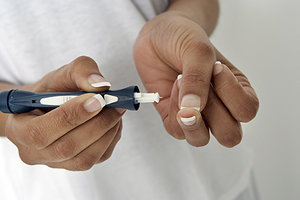There are now more than 29 million diabetics in the U.S. and 10% of them have Type 1. The incidence has been increasing in recent years at an epidemic rate. Type 1 diabetes mellitus is one of those few diseases that only respond to Western medicine treatments. The only treatment that is effective is the administration of insulin, which must be given parenterally, either by IV or by subcutaneous injection. This treatment is always lifesaving. Prior to the discovery of insulin by Banting and Best in the early 1920's, all Type 1 diabetics died from the results of their disease, usually at a very early age. Since then, diabetics have survived longer by subcutaneous injections of insulin, usually several times a day.
Until recently, the life expectancy of insulin-dependent diabetics was still dramatically foreshortened, death usually occurring in late childhood, adolescence or in a patient's twenties or thirties. However, recent improvements in the monitoring of daily changes in blood sugar levels and the administration of insulin have altered the lifestyle of these diabetics for the better and have led to much longer lifespans, with the avoidance in many cases of the dreaded complications of diabetes, such as blindness, gangrene, and kidney failure.
The best way to follow overall level of diabetic control in the long run is to measure serum hemoglobin A1c (HbA1c). This protein, red cell glycohemoglobin, changes levels with overall management, not from hour-to-hour or day-to-day: it rises with high glucose gradually, over a month or more. The red blood cell glycated Hb level is an average for the past 60 days (the half-life of red cells). The goal is to keep it below 7% (normal is 4% to 6%). A level of 6.5% is what's strived for in diabetics. Levels above 9% show poor long-term control. This should be measured every three months, or more often (in a new diabetic or somewhat unstable diabetic).
 Until recently, the life expectancy of insulin-dependent diabetics was still dramatically foreshortened, death usually occurring in late childhood, adolescence or in a patient's twenties or thirties.
In a Type 1 diabetic, however, serum glucose levels need to be monitored every day; in fact, usually several times a day, to adjust the amount of insulin that is administered. The normal serum glucose level in a healthy person is 70 to 100 mg/dL (sometimes reported as millimoles of glucose per liter, with the normal level being 4.0 to 5.6 mm/L). We strive to keep a diabetic in the range of 110 to 115 mg/dL, somewhat above normal, to avoid the possibility of going into a hypoglycemic range, which is dangerous. This requires several pinpricks of a fingertip every day with the drop of blood being placed on a paper strip that is read by a glucose meter.
Until recently, the life expectancy of insulin-dependent diabetics was still dramatically foreshortened, death usually occurring in late childhood, adolescence or in a patient's twenties or thirties.
In a Type 1 diabetic, however, serum glucose levels need to be monitored every day; in fact, usually several times a day, to adjust the amount of insulin that is administered. The normal serum glucose level in a healthy person is 70 to 100 mg/dL (sometimes reported as millimoles of glucose per liter, with the normal level being 4.0 to 5.6 mm/L). We strive to keep a diabetic in the range of 110 to 115 mg/dL, somewhat above normal, to avoid the possibility of going into a hypoglycemic range, which is dangerous. This requires several pinpricks of a fingertip every day with the drop of blood being placed on a paper strip that is read by a glucose meter.
Continuous glucose monitors (CGM) are now available that provide a better indication for proper insulin dosage. A tiny sensor is connected to a wire and is inserted into the subcutaneous tissue. The sensor reads the glucose in the interstitial fluid. It gives a continuous readout to a wireless monitor that can be carried, placed on a desk, or worn on the belt. It can be telephoned to a doctor's office if deemed desirable. The subcutaneous sensor must be replaced every seven days or so. Patients still need to do one or two finger sticks a day to verify the reading calibration of the sensor (there is a lot at stake if it gets out of adjustment. These devices reduce the complication rate and prolong life.
New devices that read blood sugar through the skin are also being studied. Some are worn like a wrist watch (larger at the moment). These devices can measure the glucose level every 15 seconds. They use ultrasound or dialectric spectroscopy (also known as impedance spectroscopy: truly amazing technology). They can even sound an alarm if sugar is too high. Unfortunately, these are still experimental, but may be available at some point in the "near future."
Insulin Pumps
An insulin pump consists of the pump (strapped to the waist), the reservoir containing the insulin (usually fast-acting regular insulin), and the cannula which is inserted under the skin into the subcutaneous tissue by means of a withdrawable needle (usually on the abdomen). The cannula is hanging out of the body, usually on the abdomen where the pump has been attached. The pump is programmed to release a low-level steady baseline dose of insulin, and then give bolus injections after meals. These can be programmed depending on the diabetic and the food he/she is consuming.
There are some definite disadvantages (compared with injections with a syringe or an insulin pen). The person must be mature and reliable (over 18 for sure) to handle the complicated pump/insulin infusion device. No body contact sports are allowed (baseball, basketball, football, skiing, snowboarding), and no aquatic sports. There is always the possibility of the cannula coming out, or the pump running dry, possibly leading to unexpected ketoacidosis. Young adults don't like to wear paraphernalia like this (yet they are often the most brittle diabetics).
Combination Sensor and Insulin Pump
A CGM sensor and transmitter can now be combined into an insulin pump so both are available at the same time with the same device. The very latest is a tubeless and wireless pump and reservoir system with bluetooth wireless transmission. This eliminates all external catheters as the insulin reservoir (a three day supply in most cases) is attached to the skin and there are no external wires or catheters to become snagged or injured.
Proven benefits of using an insulin pump: according to William Tamborlane, MD, chief of pediatric endocrinology at Yale University School of Medicine, "Recent clinical evidence clearly supports that insulin pump therapy combined with continuous glucose monitoring improves patients' A1C while reducing the relative risk of severe hypoglycemia and reducing long-term complications."
Very latest Research
The "bionic pancreas:" a device that uses a sophisticated computer program working in concert with several diabetes management devices, successfully managed blood sugar levels recently in its first real-world trials on adults and children with Type 1 diabetes. It is being developed at Boston University School of Medicine. It contains two hormones, insulin and glucagon. Insulin lowers the blood sugar and glucagon can raise blood sugar quickly. The current version of the bionic pancreas has two pumps, one that delivered small doses of insulin and the second for glucagon. The device also includes a smartphone with an app that contains the computer program to control the pumps. The phone also wirelessly communicates with a continuous glucose monitor that reports blood sugar levels every five minutes, 24 hours/day. The device is still in clinical trials but has proven to be very effective in stabilizing blood sugar levels in brittle diabetics. It should be available in about three to four years.
Some Type 1 diabetics are now living into the seventies (and possibly some into their eighties), living with a disease that used to kill everyone before the discovery of insulin and still took a heavy toll of life even with insulin injections. New developments have made a dramatic difference in the quality of life and the length of life for those with this serious disease.





